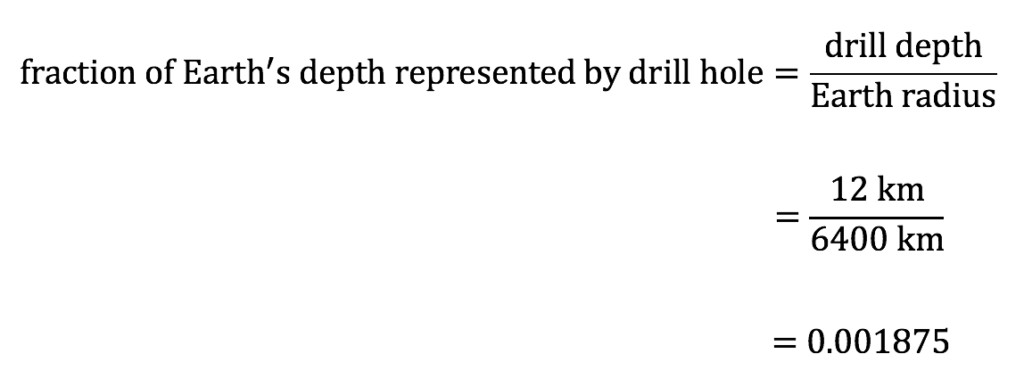Drilling into the Earth
The deepest holes ever drilled into the Earth go down about 12 kilometers. What fraction of Earth’s radius is this? Can samples of material brought up from these holes tell us much about Earth’s interior composition?
Step 1 -Understand the problem.
The question asks “what fraction . . .”, so we know we will need to divide. In this case, we’ll need to divide the drill depth of 12 kilometers by the radius of the Earth. The latter is not given, but you can easily look it up and find that Earth’s radius is approximately 6,400 kilometers.
Step 2 – Solve the problem.
We can now find the fraction simply by dividing:

Step 3 – Explain your result.
We’ve found that the deepest drill hole goes to a depth that is only 0.001875 of Earth’s radius. To give this number more context, let’s round it up as 0.002. Now we can see that the fraction is about 2/1000, or 1/500, of Earth’s radius. In other words, the distance to the center of the Earth is 500 times the deepest depth to which humans have ever drilled. Clearly, while the samples brought up can be useful, they cannot tell us much about most of the Earth’s interior, since they barely scratch the surface.
Check Your Skills
Suppose that you wanted to bring up a sample of rock from a depth that is 1% of the way from the surface to the center of the Earth. How deep would you have to drill? How does this compare to the deepest drill holes that have yet been made?
Guide your students to employ the U-S-E method to solve for the unknown in the equation: the drill depth.
Understand – The question is asking how far down you would have to drill in order to reach a depth that is 1% away from the surface of the Earth towards the center. Comparing this to the equation given in the example, help students to recognize that 1% is a percentage, and in order to use the equation, they’ll need to convert this percentage to a fraction by dividing by 100. Once they have this fraction (1/100 or 0.01) they can set up their known and unknown quantities to match the equation in the example:

Solve – Now that they have their equation set up, they need to isolate the variable that they are trying to solve for, drill depth. Multiplying both sides by 6400 km leaves drill depth independently on the right-hand side of the equation:

Explain – Doing the simple multiplication gives the result of a drill depth of 64 km. This is still a tiny fraction of the radius of the Earth. The thickness of the Earth’s crust ranges from 5km (ocean floor) to 50km (continental), therefore, depending on where the drilling was done, a hole this deep would just barely puncture the Earth’s crust into the upper mantle.